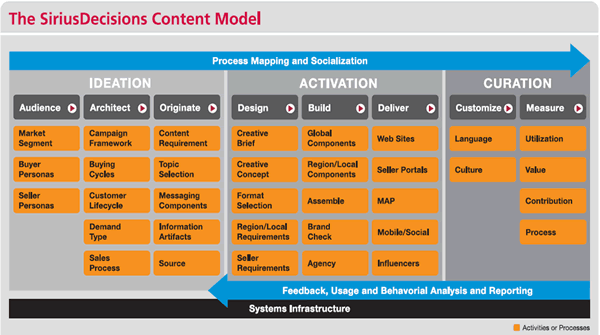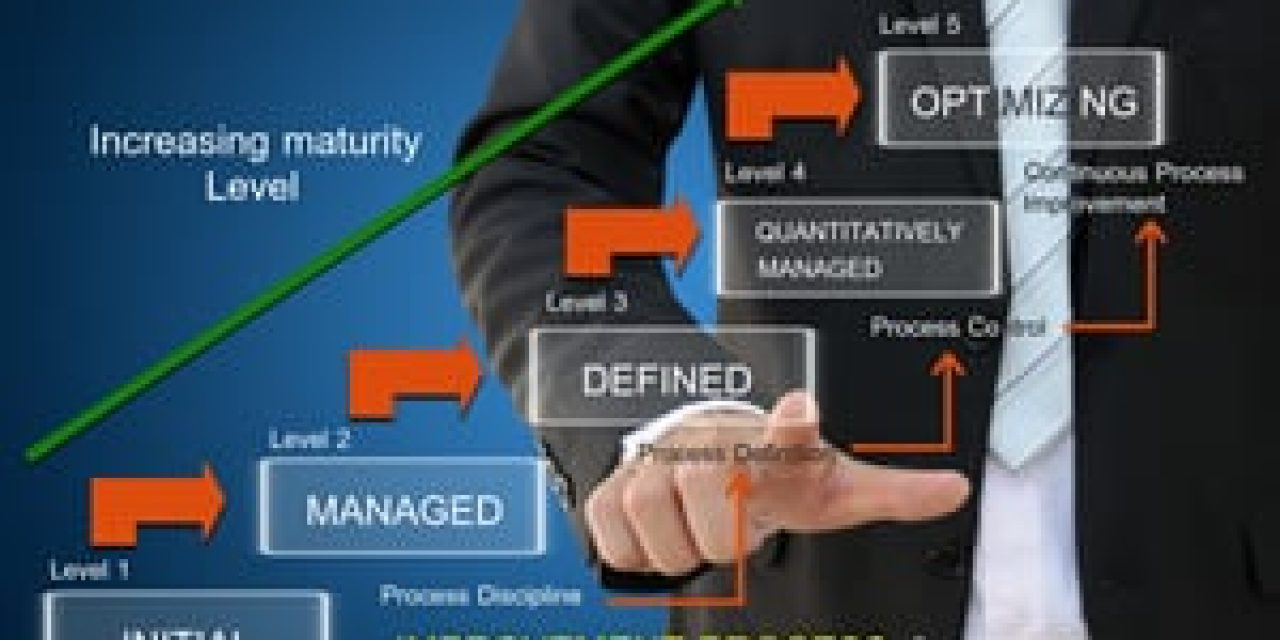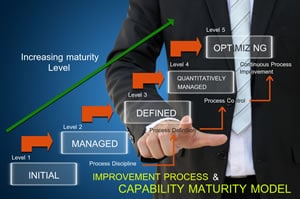
There are maturity models and roadmaps for virtually all areas of business: from community management and social business to software development, unified communications, digital business, human asset management, capabilities and project and portfolio management (PPM). The same goes for content marketing, where several content marketing maturity models exist.
They go hand in hand with content marketing roadmaps. Often, such maturity models and/or “ideal roadmaps” are used for benchmarking purposes or related with them (both are not the same). Even if many organizations like to gauge where they stand, compared to their competitors or industry averages, that’s not where the real power of a maturity model is.
And all too often, we also see models that start from the content as such and not from the customer and business goals.
The individual and connected context of a maturity model
A maturity model first of all should enable you to build a staged approach whereby each stage is detailed for your individual business and customer context.
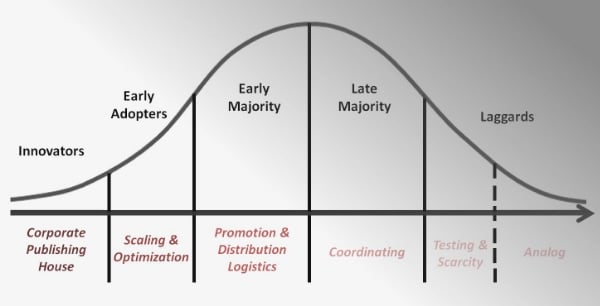
Imagine we have a content marketing maturity model or roadmap which we divide into 4 steps (note: this is not exhaustive nor ideal or “our” model, it’s just an example to make it more tangible):
- Disconnected: only ad-hoc content production for various marketing goals, little customer-centricity, focus on products, solutions and company, no strategy, different content producers with no overview of who does what (internal, external), siloed approach and an underlying disconnect of crucial divisions/stakeholders with measurement of impact only looked at on a channel level or not at all. Campaigns and short-terminism rule.
- Recognized: there is a “trigger” (can be results of a pilot or management decision, for instance) and divisions start to talk and see if a more consistent approach is possible, be it predominantly in a campaign context. Potential and need of using content marketing grows and gets recognized. Content used before in silos now starts to be used in a less ad-hoc way, with more cross-divisional approach, be it mainly on selected projects, measurement somewhat more evolved and a beginning of strategic thinking and mapping various content producers (internal/external). The Voice of the Customer starts to play a role. There is an increasing focus on what buyers and audiences want/like. Foundations are built.
- Staged: customer-centric initiatives emerge across various silos whereby content is used in a more integrated way, the overall goals and precise steps in the more mature stages of the individual roadmap get clearer. Development of a strategy whereby different divisions get involved, more mature ways of measurement, optimization mentality, involvement of customers, analysis of existing content production, resources, etc. The customer in the largest sense gets a central place and editorial guidelines and blueprints are built. A staged plan is present, including training requirements, connecting of processes, etc. The brand has a narrative.
- Connected: a content marketing strategy across the business with the involvement of all stakeholders, processes across silos, dedicated teams and resources, well-defined roles (internal, external), documented, optimization, mapping of content with business goals and customer needs, calendars, planning (production and “distribution”), systematic optimization and continuous listening, etc. Content marketing is fully integrated, teams are trained and tactics, teams and processes connected. Customer, in the broadest sense, and unique brand voice are fully connected as well.
It is perfectly possible that your business will end up in an overlapping situation of several stages in this -somewhat – hypothetical model. You could, for example, want to use content marketing to answer all the questions of your customers and other audiences (which can be enough, depending on the context) and never need dedicated teams but create a task force that captures all possible questions and makes sure they get responded through customer-oriented content.
If you would want to move to that fully connected stage, you will also take different actions, depending on your context and that of your audiences. If, for instance, you’re in stage two, the further development of your strategy, the software you need or the change management processes required, will depend on 1) what you envision to achieve in the stage you want to reach and 2) what are the pain points (business, customers,…) you want to resolve.
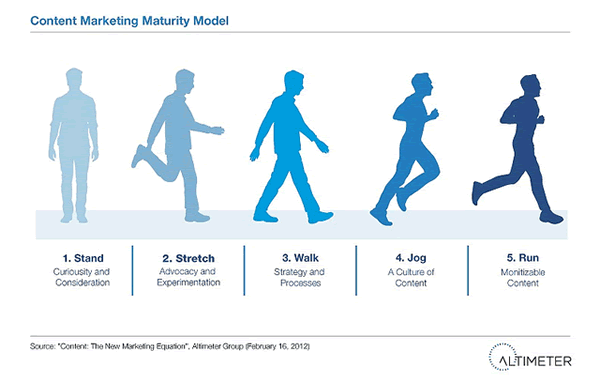
How a content marketing roadmap connects with other organizational and tatical dimensions
Another typical element of an actionable content maturity model is that is connected with the degree in which various divisions, stakeholders and silos operate and connect as mentioned in the example above.
You can’t have a fully integrated content marketing strategy if sales, marketing, PR, marcoms, customer service, the social team, etc. don’t talk with each other.
Compare this with unified communications & collaboration (UCC): you can’t have fully converged unified communications model in your business if the teams responsible for, respectively, telephony, networks and the workplace are disconnected.
There are also other elements that play a role, among others about the way your content marketing is connected with your social media marketing, community initiatives, the ways information and content are stored, extracted, combined, etc.
Tip: it makes sense to look at a content marketing roadmap from a customer experience maturity model to start with a more customer-oriented view. Example from Sitecore below.
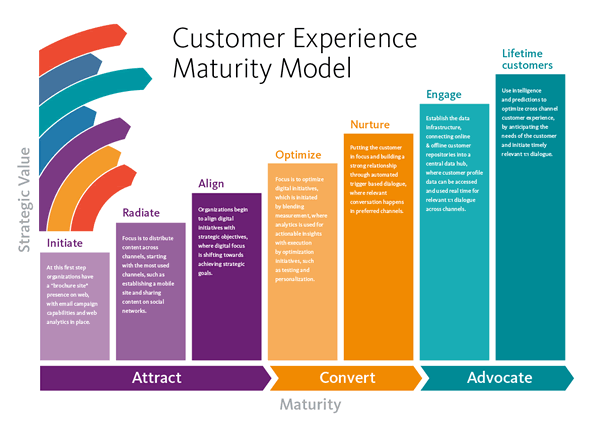
Easier buy-in with a staged content marketing roadmap
The different actions to take into account in a more personalized maturity model per stage (as translated in a roadmap), always should be defined by 1) these pain points and needs and 2) the growth path and opportunities.
Ideally, the actions you take in the first stages will also enable you to look at some low-hanging food and resolve some issues that 1) help you save costs or 2) help you grow business – directly (e.g. better online conversions, cost reductions,….) or indirectly, (e.g. better brand awareness/perception, community). This will also help you get easier internal buy-in.
Examples of wins you can achieve in early stages of your content marketing roadmap:
- Improve all your ad-hoc efforts (optimization).
- Start creating content your customers want (also saving costs regarding customer care, for instance).
- Make your content more customer-centric and improve results, impact on the pipeline, improve branding, get more sharing, etc.
- By just mapping all the efforts you do today and the internal/external resources used, you can often find ways to improve processes and save costs.
- By closing the gaps between siloed departments or roles in order to implement a content marketing roadmap and following a maturity model, many process optimization possibilities will surface, as is always the case with more or less impactful and cross-divisional exercises.
The benefits you can realize in these earlier stages, can help you fund the next stages and steps/actions, making buy-in even easier. So, get started!
